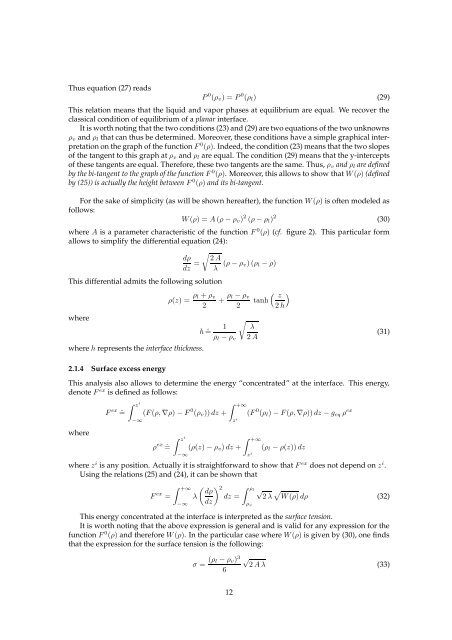Diffuse interface models in fluid mechanics
Diffuse interface models in fluid mechanics
Diffuse interface models in fluid mechanics
Create successful ePaper yourself
Turn your PDF publications into a flip-book with our unique Google optimized e-Paper software.
Thus equation (27) readsP 0 (ρ v ) = P 0 (ρ l ) (29)This relation means that the liquid and vapor phases at equilibrium are equal. We recover theclassical condition of equilibrium of a planar <strong><strong>in</strong>terface</strong>.It is worth not<strong>in</strong>g that the two conditions (23) and (29) are two equations of the two unknownsρ v and ρ l that can thus be determ<strong>in</strong>ed. Moreover, these conditions have a simple graphical <strong>in</strong>terpretationon the graph of the function F 0 (ρ). Indeed, the condition (23) means that the two slopesof the tangent to this graph at ρ v and ρ l are equal. The condition (29) means that the y-<strong>in</strong>terceptsof these tangents are equal. Therefore, these two tangents are the same. Thus, ρ v and ρ l are def<strong>in</strong>edby the bi-tangent to the graph of the function F 0 (ρ). Moreover, this allows to show that W (ρ) (def<strong>in</strong>edby (25)) is actually the height between F 0 (ρ) and its bi-tangent.For the sake of simplicity (as will be shown hereafter), the function W (ρ) is often modeled asfollows:W (ρ) = A (ρ − ρ v ) 2 (ρ − ρ l ) 2 (30)where A is a parameter characteristic of the function F 0 (ρ) (cf. figure 2). This particular formallows to simplify the differential equation (24):This differential admits the follow<strong>in</strong>g solutionwheredρdz = √2 Aλ (ρ − ρ v) (ρ l − ρ)ρ(z) = ρ l + ρ v2where h represents the <strong><strong>in</strong>terface</strong> thickness.+ ρ l − ρ v2h ˆ= 1ρ l − ρ v√λ2 A( z)tanh2 h(31)2.1.4 Surface excess energyThis analysis also allows to determ<strong>in</strong>e the energy “concentrated” at the <strong><strong>in</strong>terface</strong>. This energy,denote F ex is def<strong>in</strong>ed as follows:whereF ex ˆ=∫ zi−∞(F (ρ, ∇ρ) − F 0 (ρ v )) dz +ρ ex ˆ=∫ zi−∞∫ +∞z i(ρ(z) − ρ v ) dz +(F 0 (ρ l ) − F (ρ, ∇ρ)) dz − g eq ρ ex∫ +∞z i(ρ l − ρ(z)) dzwhere z i is any position. Actually it is straightforward to show that F ex does not depend on z i .Us<strong>in</strong>g the relations (25) and (24), it can be shown thatF ex =∫ +∞−∞λ( ) 2 ∫ dρρl√ √dz = 2 λ W (ρ) dρ (32)dzρ vThis energy concentrated at the <strong><strong>in</strong>terface</strong> is <strong>in</strong>terpreted as the surface tension.It is worth not<strong>in</strong>g that the above expression is general and is valid for any expression for thefunction F 0 (ρ) and therefore W (ρ). In the particular case where W (ρ) is given by (30), one f<strong>in</strong>dsthat the expression for the surface tension is the follow<strong>in</strong>g:σ = (ρ l − ρ v ) 36√2 A λ (33)12











![[Diffusion-Limited Aggregation - A Model for Pattern Formation].](https://img.yumpu.com/52395246/1/190x245/diffusion-limited-aggregation-a-model-for-pattern-formation.jpg?quality=85)




